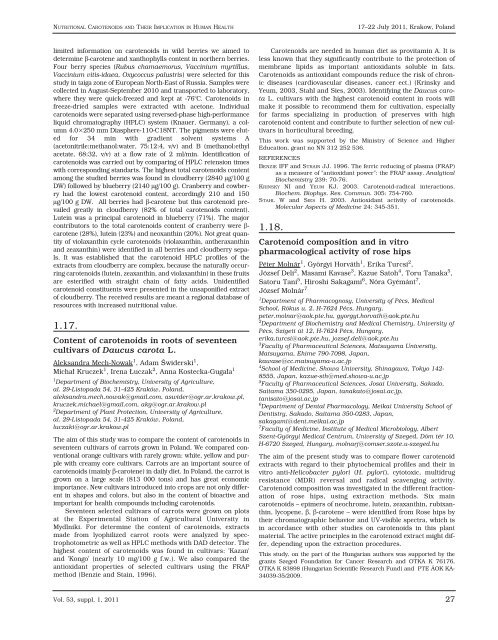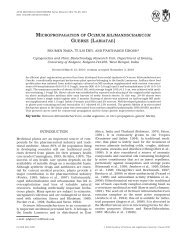ACTA BIOLOGICA CRACOVIENSIA
ACTA BIOLOGICA CRACOVIENSIA
ACTA BIOLOGICA CRACOVIENSIA
Create successful ePaper yourself
Turn your PDF publications into a flip-book with our unique Google optimized e-Paper software.
NUTRITIONAL CAROTENOIDS AND THEIR IMPLICATION IN HUMAN HEALTH<br />
limited information on carotenoids in wild berries we aimed to<br />
determine β-carotene and xanthophylls content in northern berries.<br />
Four berry species (Rubus chamaemorus, Vaccinium myrtillus,<br />
Vaccinium vitis-idaea, Oxycoccus palustris) were selected for this<br />
study in taiga zone of European North-East of Russia. Samples were<br />
collected in August-September 2010 and transported to laboratory,<br />
where they were quick-freezed and kept at -76°C. Carotenoids in<br />
freeze-dried samples were extracted with acetone. Individual<br />
carotenoids were separated using reversed-phase high-performance<br />
liquid chromatography (HPLC) system (Knauer, Germany), a column<br />
4.0×250 mm Diasphere-110-C18NT. The pigments were eluted<br />
for 34 min with gradient solvent systems A<br />
(acetonitrile:methanol:water, 75:12:4, v/v) and B (methanol:ethyl<br />
acetate, 68:32, v/v) at a flow rate of 2 ml/min. Identification of<br />
carotenoids was carried out by comparing of HPLC retension times<br />
with corresponding standarts. The highest total carotenoids content<br />
among the studied berries was found in cloudberry (2840 μg/100 g<br />
DW) followed by blueberry (2140 μg/100 g). Cranberry and cowberry<br />
had the lowest carotenoid content, accordingly 210 and 150<br />
μg/100 g DW. All berries had β-carotene but this carotenoid prevailed<br />
greatly in cloudberry (82% of total carotenoids content).<br />
Lutein was a principal carotenoid in blueberry (71%). The major<br />
contributors to the total carotenoids content of cranberry were βcarotene<br />
(28%), lutein (23%) and neoxanthin (20%). Not great quantity<br />
of violaxanthin cycle carotenoids (violaxanthin, antheraxanthin<br />
and zeaxanthin) were identified in all berries and cloudberry sepals.<br />
It was established that the carotenoid HPLC profiles of the<br />
extracts from cloudberry are complex, because the naturally occurring<br />
carotenoids (lutein, zeaxanthin, and violaxanthin) in these fruits<br />
are esterified with straight chain of fatty acids. Unidentified<br />
carotenoid constituents were presented in the unsaponified extract<br />
of cloudberry. The received results are meant a regional database of<br />
resources with increased nutritional value.<br />
1.17.<br />
Content of carotenoids in roots of seventeen<br />
cultivars of Daucus carota L.<br />
Aleksandra Mech-Nowak1 , Adam Świderski1 ,<br />
Michał Kruczek1 , Irena Łuczak2 , Anna Kostecka-Gugała1 1Department of Biochemistry, University of Agriculture,<br />
al. 29-Listopada 54, 31-425 Kraków, Poland,<br />
aleksandra.mech.nowak@gmail.com, aswider@ogr.ar.krakow.pl,<br />
kruczek.michael@gmail.com, akg@ogr.ar.krakow.pl<br />
2Department of Plant Protection, University of Agriculture,<br />
al. 29-Listopada 54, 31-425 Kraków, Poland,<br />
luczaki@ogr.ar.krakow.pl<br />
The aim of this study was to compare the content of carotenoids in<br />
seventeen cultivars of carrots grown in Poland. We compared conventional<br />
orange cultivars with rarely grown: white, yellow and purple<br />
with creamy core cultivars. Carrots are an important source of<br />
carotenoids (mainly β-carotene) in daily diet. In Poland, the carrot is<br />
grown on a large scale (813 000 tons) and has great economic<br />
importance. New cultivars introduced into crops are not only different<br />
in shapes and colors, but also in the content of bioactive and<br />
important for health compounds including carotenoids.<br />
Seventeen selected cultivars of carrots were grown on plots<br />
at the Experimental Station of Agricultural University in<br />
Mydlniki. For determine the content of carotenoids, extracts<br />
made from lyophilized carrot roots were analyzed by spectrophotometric<br />
as well as HPLC methods with DAD detector. The<br />
highest content of carotenoids was found in cultivars: 'Kazan'<br />
and 'Kongo' (nearly 10 mg/100 g f.w.). We also compared the<br />
antioxidant properties of selected cultivars using the FRAP<br />
method (Benzie and Stain, 1996).<br />
Vol. 53, suppl. 1, 2011<br />
Carotenoids are needed in human diet as provitamin A. It is<br />
less known that they significantly contribute to the protection of<br />
membrane lipids as important antioxidants soluble in fats.<br />
Carotenoids as antioxidant compounds reduce the risk of chronic<br />
diseases (cardiovascular diseases, cancer ect.) (Krinsky and<br />
Yeum, 2003, Stahl and Sies, 2003). Identifying the Daucus carota<br />
L. cultivars with the highest carotenoid content in roots will<br />
make it possible to recommend them for cultivation, especially<br />
for farms specializing in production of preserves with high<br />
carotenoid content and contribute to further selection of new cultivars<br />
in horticultural breeding.<br />
This work was supported by the Ministry of Science and Higher<br />
Education, grant no NN 312 252 536.<br />
REFERENCES<br />
BENZIE IFF and STRAIN JJ. 1996. The ferric reducing of plasma (FRAP)<br />
as a measure of "antioxidant power": the FRAP assay. Analytical<br />
Biochemistry 239: 70-76.<br />
KRINSKY NI and YEUM KJ. 2003. Carotenoid-radical interactions.<br />
Biochem. Biophys. Res. Commun. 305: 754-760.<br />
STAHL W and SIES H. 2003. Antioxidant activity of carotenoids.<br />
Molecular Aspects of Medicine 24: 345-351.<br />
1.18.<br />
17–22 July 2011, Krakow, Poland<br />
Carotenoid composition and in vitro<br />
pharmacological activity of rose hips<br />
Péter Molnár 1 , Györgyi Horváth 1 , Erika Turcsi 2 ,<br />
József Deli2 , Masami Kavase 3 , Kazue Satoh 4 , Toru Tanaka 5 ,<br />
Satoru Tani 5 , Hiroshi Sakagami 6 , Nóra Gyémánt 7 ,<br />
József Molnár 7<br />
1 Department of Pharmacognosy, University of Pécs, Medical<br />
School, Rókus u. 2, H-7624 Pécs, Hungary,<br />
peter.molnar@aok.pte.hu, gyorgyi.horvath@aok.pte.hu<br />
2 Department of Biochemistry and Medical Chemistry, University of<br />
Pécs, Szigeti út 12, H-7624 Pécs, Hungary,<br />
erika.turcsi@aok.pte.hu, jozsef.deli@aok.pte.hu<br />
3 Faculty of Pharmaceutical Sciences, Matsuyama University,<br />
Matsuyama, Ehime 790-7098, Japan,<br />
kawase@cc.matsuyama-u.ac.jp<br />
4 School of Medicine, Showa University, Shinagawa, Tokyo 142-<br />
8555, Japan, kazue-sth@med.showa-u.ac.jp<br />
5 Faculty of Pharmaceutical Sciences, Josai University, Sakado,<br />
Saitama 350-0295, Japan, tanakato@josai.ac.jp,<br />
tanisato@josai.ac.jp<br />
6 Department of Dental Pharmacology, Meikai University School of<br />
Dentistry, Sakado, Saitama 350-0283, Japan,<br />
sakagami@dent.meikai.ac.jp<br />
7 Faculty of Medicine, Institute of Medical Microbiology, Albert<br />
Szent-Györgyi Medical Centrum, University of Szeged, Dóm tér 10,<br />
H-6720 Szeged, Hungary, molnarj@comser.szote.u-szeged.hu<br />
The aim of the present study was to compare flower carotenoid<br />
extracts with regard to their phytochemical profiles and their in<br />
vitro anti-Helicobacter pylori (H. pylori), cytotoxic, multidrug<br />
resistance (MDR) reversal and radical scavenging activity.<br />
Carotenoid composition was investigated in the different fractionation<br />
of rose hips, using extraction methods. Six main<br />
carotenoids – epimers of neochrome, lutein, zeaxanthin, rubixanthin,<br />
lycopene, β, β-carotene – were identified from Rose hips by<br />
their chromatographic behavior and UV-visible spectra, which is<br />
in accordance with other studies on carotenoids in this plant<br />
material. The active principles in the carotenoid extract might differ,<br />
depending upon the extraction procedures.<br />
This study, on the part of the Hungarian authors was supported by the<br />
grants Szeged Foundation for Cancer Research and OTKA K 76176,<br />
OTKA K 83898 (Hungarian Scientific Research Fund) and PTE ÁOK KA-<br />
34039-35/2009.<br />
27












